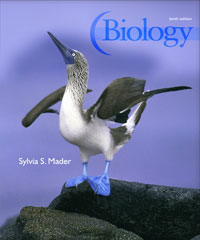Biology (Mader), 10th EditionChapter 23:
Plant Evolution and DiversityLearning OutcomesAfter studying this chapter, you should be able to accomplish the following outcomes. The Green Algal Ancestor of Plants - Give four features of charophytes which are consistent with their sharing a common ancestor sometime in the past with plants.
- Draw an evolutionary tree for plants showing significant innovations during their evolution.
- Distinguish between the sporophyte and the gametophyte in the plant life cycle.
- Associate the increased dominance of the sporophyte with plant adaptations to the land environment.
Evolution of Bryophytes: Colonization of Land- Name and describe the three types of bryophytes.
- In what ways are Bryophytes adapted and not fully adapted to living on land?
- Explain a diagram of the moss life cycle, pointing out significant events.
Evolution of Lycophytes: Vascular Tissue- Describe Lycopodium, a ground pine.
- Explain the observation that lycophytes but not bryophytes have roots, stems, and leaves.
- Explain why the leaves of lycophytes are termed microphylls.
Evolution of Pteridophytes: Megaphylls
- Name and describe three types of pteridophytes.
- Explain why the leaves of pteridophytes are termed megaphylls.
- Explain a diagram of the fern life cycle, pointing out significant events.
Evolution of Seed Plants: Full Adaptation to Land
- Define a seed and explain how a seed plant life cycle differs from that of a seedless vascular plant.
- Name and describe the significant difference between the two major types of seed plants.
- Name and describe four groups of gymnosperms.
- Describe the carboniferous period and tell what types of plants contributed the most to coal-forming forests.
- Name the two major types of flowering plants and state their differences.
- Describe the parts of a flower and their functions; explain how pollinators contributed to the diversification of flowers.
- Explain a diagram of the pine and flowering plant life cycles, pointing out significant events.
 | 
















